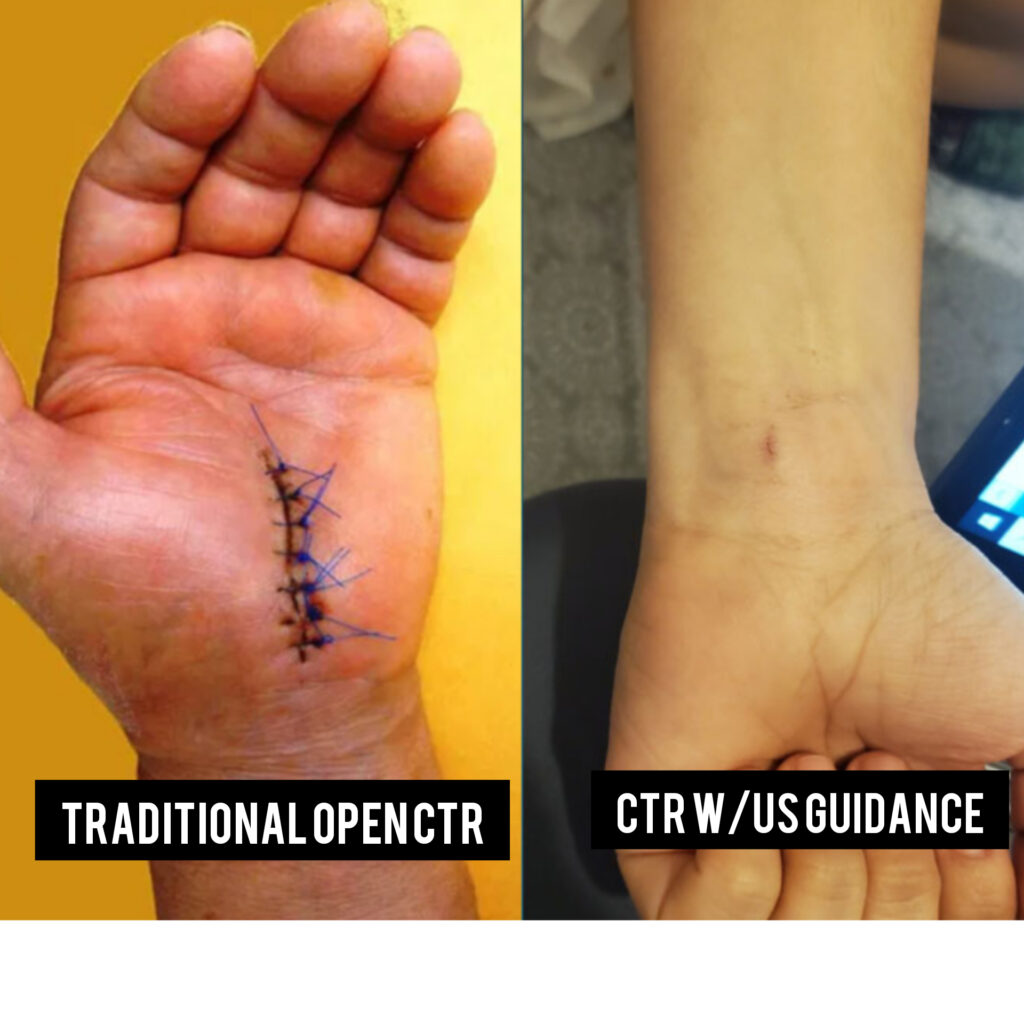Carpal Tunnel Syndrome (CTS)
CTS typically involves pain, numbness, tingling and weakness in the fingers of the hand or palm. These symptoms can sometimes radiate up the forearm and become worse while sleeping or with repetitive activities. CTS occurs when the median nerve, one of the major nerves in the arm, is compressed as it travels through the carpal tunnel. This nerve can be compressed by the transcarpal ligament or the flexor tendons that it lives next to in the wrist (see picture). CTS affects more than 12 million people nationwide and will affect ~10% of the population at some point in their lives.

How is Carpal Tunnel Syndrome Diagnosed?
A diagnosis of Carpal Tunnel Syndrome is often made clinically at first. If the patient’s symptoms tell the classic story of CTS then this is usually the case. There are valid questionnaires that can predict with a degree of accuracy if someone has carpal tunnel syndrome like the Kamath and Stothard Carpal Tunnel Questionnaire.
THINK YOU HAVE CARPAL TUNNEL SYNDROME?
Download this 5-minute questionnaire to find out if you might have CTS.
Additionally, a physician will often perform a number of physical exam maneuvers on the patient that may be positive in a patient with CTS although these actually have less sensitivity.
There are also several diagnostic tests designed to objectively find evidence of carpal tunnel syndrome. The most commonly performed diagnostic test is called a Nerve Conduction Study and Electromyography. In this study electrodes are placed along the path of several nerves in the hand and wrist. Then a pulse of electrical stimulation is sent through the various nerves so that the speed of the signal along each nerve can be measured. Through this test, the physician can tell if the median nerve is damaged compared to the other nerves. The physician can also tell where damage is likely coming from. See picture below. The physician will often follow this up with putting a needle that acts as a microphone into several muscles in the hand and arm to assess the ‘nerve to muscle’ connection. This test is an excellent tool to diagnose carpal tunnel syndrome, but it has its downsides. Unfortunately, the test is often rather uncomfortable for patients and is associated with pain when stimulating along the nerve and when needling the various muscles.

Another option is diagnostic ultrasound. Using a musculoskeletal ultrasound machine a physician can obtain measurements of the cross sectional area of the median nerve at the carpal tunnel. These measurements can tell the physician if the patient has objective evidence of carpal tunnel syndrome in a matter of moments. The ultrasound is also cheaper and does not have any pain associated with the procedure.

How is Carpal Tunnel Syndrome Treated?
Initially, CTS is often treated with bracing, stretching, activity modification, and NSAIDs. It may also be treated with steroid or platelet injections. However if symptoms persist, it is typically recommended that patients undergo a surgical procedure to cut the ligament of the carpal tunnel and give the nerve more room.
Traditional Carpal Tunnel Release Surgery
CTS surgery is called carpal tunnel release (CTR), which relieves pressure on the median nerve by cutting the transverse carpal ligament. Traditional CTR procedures can remedy the condition, but often result in large and sometimes painful scars, ongoing palmar pain, and a longer road to recovery.

A Less Invasive Approach to Treat Carpal Tunnel Syndrome for Fast Recovery
Now there’s a proven way to get rapid relief from carpal tunnel pain and return quickly to normal activities.
Micro-invasive Treatment of Carpal Tunnel Syndrome
Carpal tunnel release under ultrasound guidance involves a safe, and effective instrument that allows the doctor to perform carpal tunnel release in a matter of minutes. When combined with ultrasound visualization, the procedure requires only a small wrist incision.
Significant Benefits of Carpal Tunnel Release with Ultrasound Guidance
- Performed in a procedure room or office setting
- Can be performed using local anesthesia
- Small wrist incision is typically closed without sutures
- Reduces or eliminates the need for opioids
- Postoperative therapy is typically not required—saving you time and money
- Immediate motion in the hand for rapid recovery
- Return to normal activity in a few days, not months
After the procedure, you’ll be able to resume activities as tolerated—most patients can return to work and the activities they love within 3-6 days.

If you or someone you know is interested in this innovative procedure, please contact us today.
References:
- Nakamichi K, Tachibana S, Yamamoto S, et al. Percutaneous carpal tunnel release compared with mini-open release using ultrasonographic guidance for both techniques. J Hand Surg Am. 2010 Mar;35(3):437-445.
- Rojo-Manaute JM, Capa-Grasa A, Chana-Rodriguez F, et al. Ultra-minimally invasive sonographically guided carpal tunnel release: a randomized clinical trial. J Ultrasound Med. 2016 Jun;35(6):1149-1157.
- Henning PT, Yang L, Awan T, et al. Minimally invasive ultrasound-guided carpal tunnel release: preliminary clinical results. J Ultrasound Med. 2018 Nov;37(11):2699-2706.



